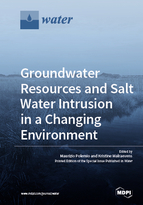Groundwater Resources and Salt Water Intrusion in a Changing Environment
A special issue of Water (ISSN 2073-4441). This special issue belongs to the section "Hydrology".
Deadline for manuscript submissions: closed (30 September 2018) | Viewed by 78981
Special Issue Editors
Interests: groundwater management; seawater intrusion; groundwater monitoring
Special Issues, Collections and Topics in MDPI journals
Interests: hydrogeology; hydrogeochemistry; EIA; applied geophysics
Special Issues, Collections and Topics in MDPI journals
Special Issue Information
Dear Colleagues,
The salinisation of groundwater resources can be caused by natural phenomena and anthropogenic activities. Approximately 16% of the total area of continental Earth is potentially involved in groundwater salinisation; seawater intrusion can be considered to be the prevalent phenomenon in terms of potential effects and risks. Water and chemical fluxes, including nutrient loading, at the terrestrial/marine interface and across the sea floor, provide an important linkage between terrestrial and marine environments.
Climate and global change impacts on the hydrological cycle, water resources and ecosystems pose great challenges for global water and ecosystem management especially where the ecological equilibria are strongly depending on groundwater-surface water interaction. The climate change scenarios require new and improved integrated tools for the assessment of climate change impacts on the hydrological cycle. Coastal aquifers and ecosystems are currently under pressure globally from overexploitation and saltwater intrusion. Population growth and progressive gathering in coastal areas, climate change and sea level rise will enhance the pressures and the need for protection and sustainable management of coastal groundwater resources and ecosystems for coastal communities in the future.
This Special Issue of Water calls any contribution on previous subjects which include any useful innovative scientific activities. A non-exhaustive list of desired contributions includes tools, equipment, methods, modelling, and/or experiences on: Hydrogeological, geophysical, geochemical mapping and characterization of the subsurface involving the distribution of freshwater and saltwater; assessment of climate change impact on groundwater resources in coastal areas in terms of quantity and quality and ecosystem status; tools for efficient online visualization and dissemination; risk and vulnerability assessment methods; management approaches; and monitoring experiences.
Dr. Maurizio Polemio
Prof. Dr. Kristine Walraevens
Guest Editors
Manuscript Submission Information
Manuscripts should be submitted online at www.mdpi.com by registering and logging in to this website. Once you are registered, click here to go to the submission form. Manuscripts can be submitted until the deadline. All submissions that pass pre-check are peer-reviewed. Accepted papers will be published continuously in the journal (as soon as accepted) and will be listed together on the special issue website. Research articles, review articles as well as short communications are invited. For planned papers, a title and short abstract (about 100 words) can be sent to the Editorial Office for announcement on this website.
Submitted manuscripts should not have been published previously, nor be under consideration for publication elsewhere (except conference proceedings papers). All manuscripts are thoroughly refereed through a single-blind peer-review process. A guide for authors and other relevant information for submission of manuscripts is available on the Instructions for Authors page. Water is an international peer-reviewed open access semimonthly journal published by MDPI.
Please visit the Instructions for Authors page before submitting a manuscript. The Article Processing Charge (APC) for publication in this open access journal is 2600 CHF (Swiss Francs). Submitted papers should be well formatted and use good English. Authors may use MDPI's English editing service prior to publication or during author revisions.
Keywords
- salt water intrusion
- groundwater resources
- coastal aquifer
- climate change
- modelling
- monitoring
- salinisation
- water resources management
- aquifer vulnerability
- groundwater degradation







